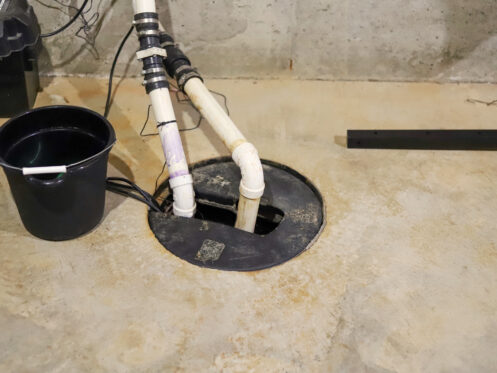The snow is finally melting. After months of icy sidewalks and shoveling driveways, you’re probably more than ready to welcome spring. But as the slush disappears, all that melting snow has to go somewhere. Sometimes, that “somewhere” is right in your basement.
At F.F. Hitchcock Plumbing, Heating & Cooling in Cheshire, CT, we’ve helped plenty of homeowners stay dry when the snow starts to thaw, and we know a few tricks that can make all the difference. A few steps now can save you from the stress (and smell) of a flooded basement later.
How Snowmelt Finds Its Way Into Your Basement
You probably don’t think too much about what happens to snow after it melts. But when that snow melts fast—especially after a heavy winter—it doesn’t always soak in as you’d expect. Instead, it can pool around your house, looking for any crack, gap, or weak spot to sneak inside. That’s when you run into problems.
The ground around your foundation can only take so much water before it gets overwhelmed. Once that happens, the water looks for other places to go. If your basement walls have even the tiniest crack, or the ground slopes toward your house instead of away, that water finds a way in. You might first notice a damp smell or see a dark spot on the concrete floor. Other times, it’s more dramatic—like stepping onto a wet carpet or seeing a puddle under your storage shelves.
It doesn’t always take a big flood to cause damage, either. That slow trickle from melting snow can soak into your walls over days or weeks. By the time you spot it, you might already be dealing with warped baseboards or a musty basement smell that won’t go away. Keeping snowmelt out is about more than avoiding puddles; it’s about protecting your home from the kind of damage that’s harder to see until it’s too late.
The Sump Pump: Your Basement’s Best Defense
If you’ve never had to think about your sump pump, consider yourself lucky. But when snowmelt starts seeping toward your basement, that little pump down in the corner becomes your best friend. It’s the thing standing between you and a wet floor when water starts pushing up against your foundation.
Sump pumps sit in a pit—sometimes called a sump basin—usually at the lowest spot in your basement. When water builds up in that pit, the pump kicks on and pushes the water away from your house. You might not even notice it working most of the time, but when it fails, you’ll know. Water will start rising fast, and that’s when you find yourself scrambling to move boxes and throw towels down.
Testing your sump pump before snowmelt season hits can save you from that panic. You can do it yourself by pouring a bucket of water into the pit and checking that the pump turns on. If it doesn’t, there might be something wrong with the float switch, or the pump itself could be worn-out. Pumps don’t last forever—usually about seven to 10 years—so if yours is getting older, it might be time to replace it before it quits on you when you need it most.
Why Gutters and Downspouts Matter More Than You Think
Gutters probably aren’t the first thing that comes to mind when you think about basement flooding. But they play a big part in keeping water away from your foundation. When snow melts off your roof, it runs into your gutters, which are supposed to carry it safely away. If those gutters are clogged with leaves or ice, that water spills over and ends up right next to your house.
Once water starts pooling around your foundation, it doesn’t take much for it to work its way into your basement. That’s why checking your gutters before spring can save you from headaches later. Clear out any leaves, sticks, or debris that built up over the fall and winter. Make sure your downspouts are pointed away from your house—at least a few feet. If the water’s just running straight down and pooling next to your wall, it’s basically an invitation for a leak.
Sometimes, downspouts get damaged over the winter. Maybe an ice dam weighed them down, or snow sliding off the roof bent one. If you notice a dent or crack, it’s worth fixing it before that spring thaw hits.
Checking for Cracks Before They Become Problems
Basement walls are tough, but they’re not indestructible. Over time, small cracks can form—sometimes so small you don’t even notice them until water starts seeping through. Those cracks might start as hairline lines across the concrete, but as water from melting snow pushes against them, they can widen and let more water in.
Walking around your basement and inspecting the walls is a good habit before spring. Look closely at the corners and along the base where the wall meets the floor. If you see any cracks, or if a section of the wall looks darker than the rest, it could mean water is already finding its way in.
Even small cracks can grow when water freezes and thaws inside them. Sealing those up with waterproof caulk or hydraulic cement can help stop leaks before they get worse. But if you notice a crack that looks wide or if water is already coming through, it’s a good idea to get it checked by a professional.
Basement Window Problem
Basement windows let in light, but they can also let in water if they’re not properly sealed. Snow piled up against those windows can melt and drip into gaps around the frame. Sometimes, older windows develop cracks in the glass or rot around the frame, making them an easy target for leaks.
Checking your basement windows before the snow starts melting can save you a lot of trouble later. Run your hand along the edges and see if you feel any drafts. If you see gaps, cracks, or peeling caulk, water can get in there. Resealing the area around the window with fresh caulk is a simple fix that can keep the water out.
If your windows have window wells, make sure they’re clear of leaves, snow, or debris. Those wells can fill up fast during a thaw, and if they overflow, that water is heading straight into your basement. Installing a window well cover can help keep water and debris out while still letting light in.
When to Call for Backup
Sometimes, despite your best efforts, water still finds a way in. You may notice a damp spot along your wall, or your sump pump is running nonstop after heavy snowmelt. When that happens, waiting can make things worse. Water damage can sneak up quickly, and what looks like a small issue can grow into mold, damaged flooring, or weakened walls.
Calling in someone who knows what to look for can help you catch the problem before it gets out of hand. They can check your foundation, inspect your sump pump, and make sure your drainage system is working as it should.
Getting help early can save you from dealing with water damage later. It’s always better to get ahead of a problem before it turns into a flooded basement. Taking action when you spot the first sign of trouble can keep your home dry, your basement usable, and your mind at ease when the snow starts melting.
Call Us Today
Snowmelt season doesn’t have to mean mopping up water or worrying every time you hear rain in the forecast. Checking your sump pump, clearing out gutters, and keeping an eye on your foundation can go a long way toward keeping your basement dry. If you need help getting your home ready before the snow melts, or if you’ve noticed water creeping in already, schedule a visit with F.F. Hitchcock Plumbing, Heating & Cooling today for all your plumbing needs, including plumbing repair, drain cleaning and more.








